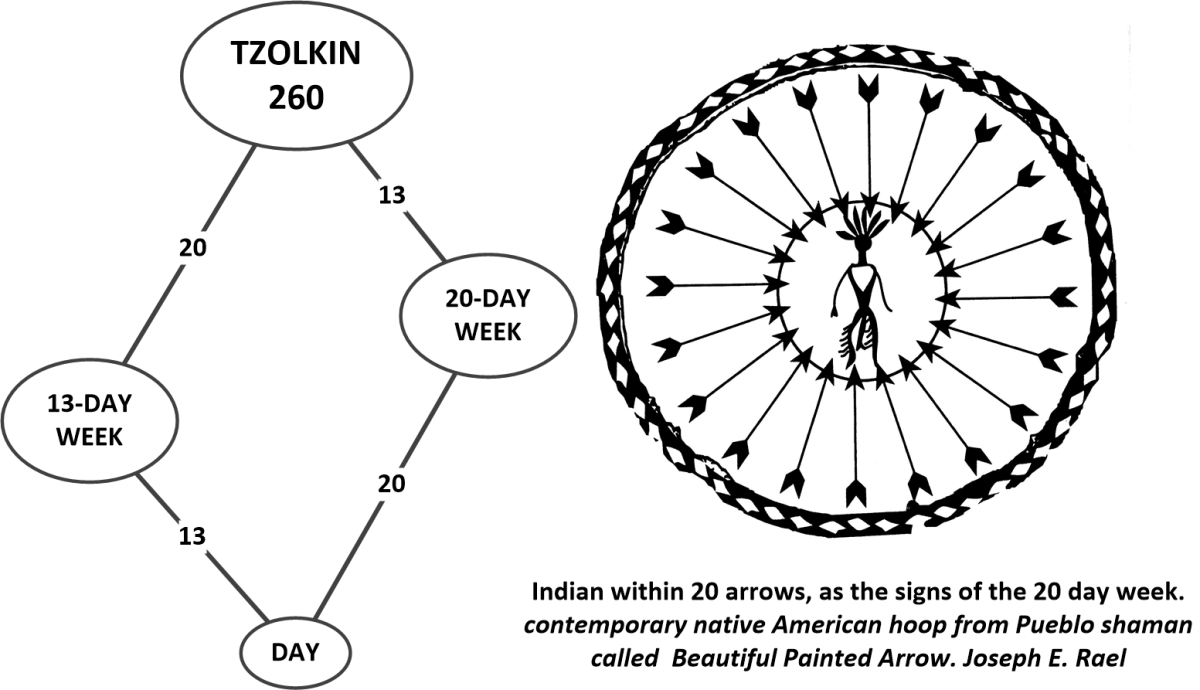diagram: the interaction of two types of week creating a sacred calendar of 260 days. text: from Sacred Number blog, Saturday, November 8, 2008
In 2008, William Sullivan sent me an explanation for why the Mayan time system used 260 days as a sacred or ritual year, counting 13 and 20 day periods (that divide into this), to characterize days of one’s birth.
Robert D. Peden pointed out that: “The Mayan Ritual year of 260 days was successful for one major reason – after a cycle lasting 59 Ritual years, the tropical year and the Ritual year lock together in step. A period of 59 by 260 days equals a period of 42 tropical years, of 365.242 days.”. He therefore thought that (a) the Maya Long count was a lunar calendar. (b) The Accounting year of 364 days might be considered a Venus calendar. (c) 104 years is the natural and optimum intercalation time to correct the solar and Venus calendars – and is the basis of the Mesoamerican Calendar Round. The first and other observations can be accessed for accuracy:
- 42 Solar years [of 365.242] = 59 x 260 (accurate to 4 minutes)
- 405 Lunar Months [of 29.53059] = 46 x 260 (accurate to 3.5 minutes)
- 61 Venus Synods [of 583.92] = 137 x 260 (accurate to 9.25 minutes)
- 1 Mars Synod [of 779.94] = 3 x 260 (accurate to 28.8 minutes)
- 88 Jupiter Synods [of 398.88] = 135 x 260 (accurate to 15.36 minutes)
“It is proposed that these factual astronomical derivations [and some others] are ipso facto sufficient to prove the astronomical base for the Mesoamerican calendrical system.”
This extended my own work in Matrix of Creation, the book. It should give a whole new impetus to the Mayan “calendar”, for those interested and academics alike. The main inference here is the uncanny way in which time is organised on Earth and how the uncanny ancestors tuned into it through their sacred structures including their calendars. The 260-day calendar is an original cultural work and some say (e.g. Jose Arguelles), it is a form of time that comes from higher levels of order within the galaxy.
References: The standard archaeological work, obviously conservative but reliable, is The Ancient Maya by Robert Sharer. Georges Ifrah wrote an excellent collection called Numbers which covers the Maya well and other books abound from all manner of viewpoints.
I will be adding to this entry as I re-engage with this unlikely system of time, technically called an Almanac of 260 days and somewhat different from the Maya Calendarwith base-20 days in a 360 day year and the Haabof 365 days.
It is often possible to find a formula for a cosmic constant using a favourite number or two, in this case 13 and 20. It is worthwhile working through what this was for the Maya and their calendrical counting expertise in which time periods needed to be reconciled using such formulas, if those cycles were going to remain accurately synchronised with observations. So,
The solar yearFrom Earth: the time in which the sun moves once around the Zodiac, now known to be caused by the orbital period of the Earth around the Sun. = 365.2422 days is equated here with 59 x 260 / 42. Cancelling the prime numbers leads to the minimal formula of,
The solar year = 2 x 5 x 13 x 59 / 3 x 7 which would make it, 365.238 days long. This is accurate to one part in 89,000 or about six minutes per year so that this “equation” would slip by one day after 240 years. After ten years, it would be 1/24 of a day out or one hour so that every 240 years, one could set back the almanac of 260 days by one day, since it is based upon whole days.

